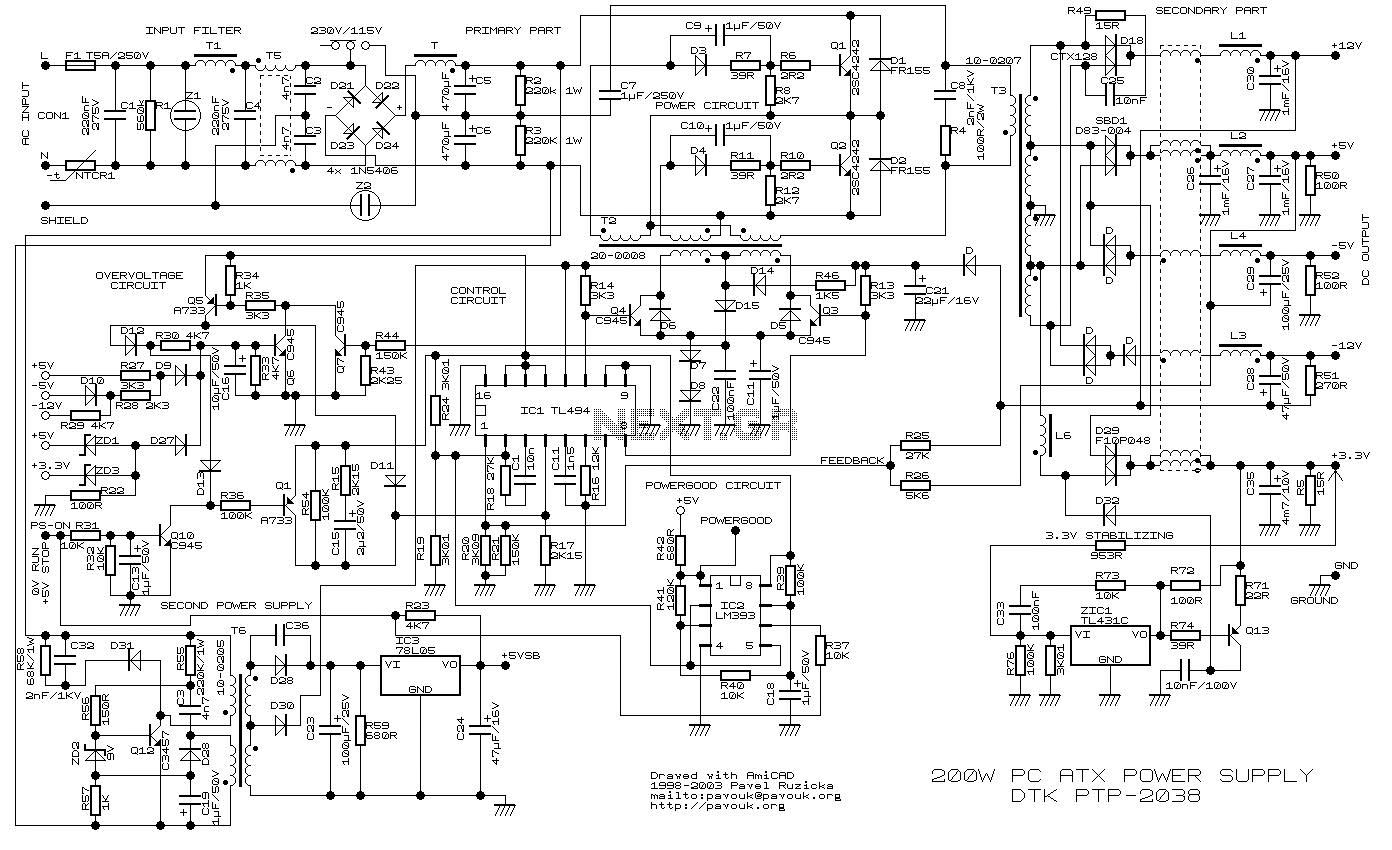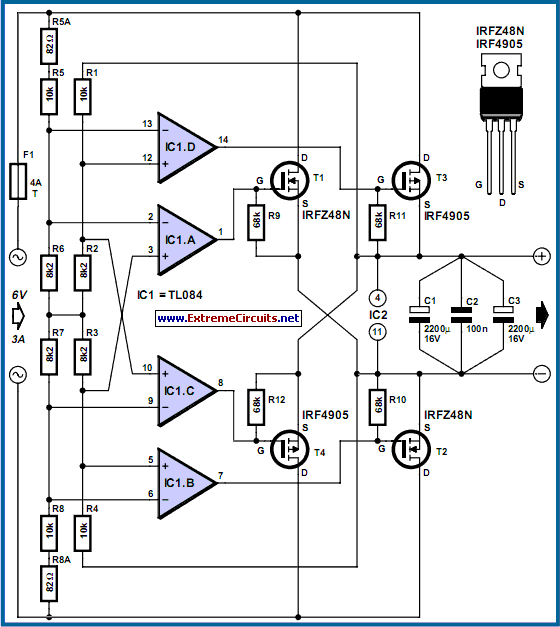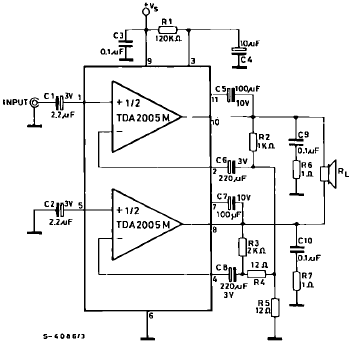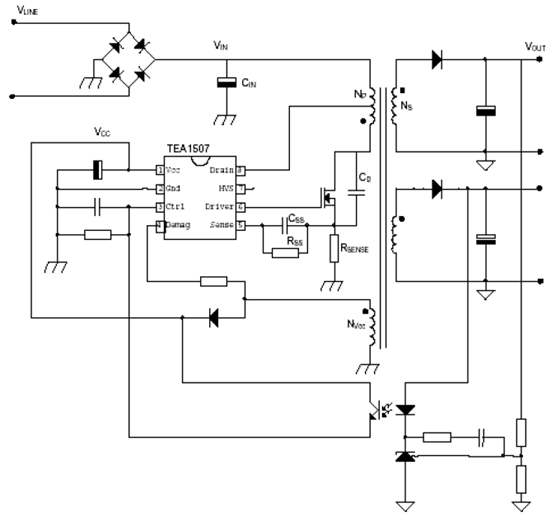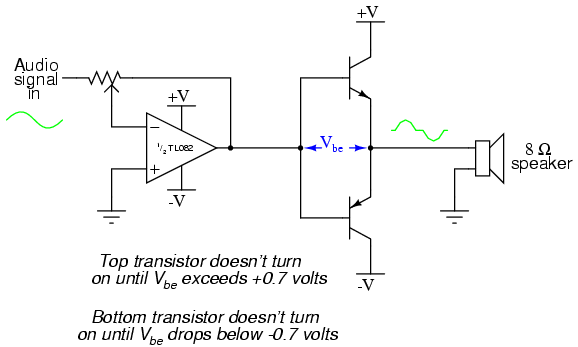
USB Powered Audio Power Amplifier
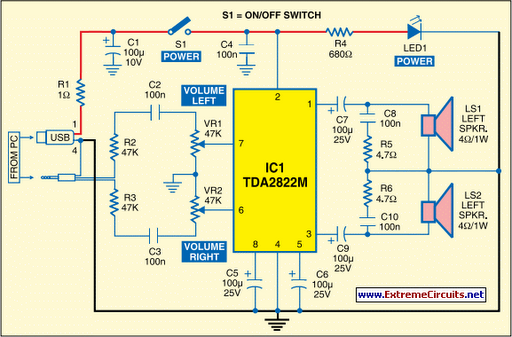
This circuit for multimedia speakers designed for PCs utilizes a single-chip architecture, operates on a low-voltage power supply, is compatible with USB power, facilitates easy heat dissipation, is cost-effective, offers high flexibility, and has a wide temperature tolerance. Central to the circuit is the IC TDA2822M, a monolithic device housed in an 8-lead mini DIP package. It is specifically intended for use as a dual audio power amplifier in battery-operated sound players. The specifications of the TDA2822M include low quiescent current, minimal crossover distortion, a supply voltage range down to 1.8 volts, and a minimum output power of approximately 450 mW per channel with a 4-ohm loudspeaker at a 5V DC supply input. An ideal power amplifier is defined as a circuit capable of delivering audio power to external loads without significant signal distortion and without excessive quiescent current consumption. This circuit is powered by a 5V DC supply sourced from the USB port of the PC. When the power switch S1 is activated to the "on" position, the 5V power supply is routed to the circuit, and the power-indicator red LED1 illuminates immediately. Resistor R1 serves as a current surge limiter, while capacitors C1 and C4 act as buffers. The circuit operates by feeding audio signals from the PC audio socket or headphone socket into the amplifier circuit through components R2 and C2 (for the left channel) and R3 and C3 (for the right channel). Potentiometer VR1 functions as the volume control for the left (L) channel, while potentiometer VR2 serves the same purpose for the right (R) channel. Pin 7 of the TDA2822M receives the left-channel audio signals, and pin 6 receives the right-channel audio signals through VR1 and VR2, respectively. The amplified audio signals intended for the left and right loudspeakers are available at pins 1 and 3 of the IC, respectively. Components R5 and C8, along with R6 and C10, form a traditional Zobel network. It is recommended to assemble the circuit on a medium-sized, general-purpose PCB and to enclose it in an appropriate cabinet. Utilizing a socket for the TDA2822M IC is advisable, and external connections should be made using suitably shielded wires for optimal performance.
The multimedia speaker circuit design is a compact and efficient solution for audio amplification in PC environments. The integration of the TDA2822M IC allows for a streamlined assembly while ensuring high-quality audio output with minimal distortion. The use of USB power not only simplifies the power supply requirements but also enhances portability, making the circuit suitable for various applications, including portable sound systems.
The circuit's design incorporates essential protective elements such as the current surge limiter (R1) and buffer capacitors (C1 and C4), which help maintain stability and prevent damage to sensitive components during operation. The inclusion of volume control potentiometers (VR1 and VR2) enables user customization of audio levels, enhancing the user experience.
The Zobel network formed by resistors and capacitors (R5, C8, R6, and C10) is critical for maintaining frequency response and stability in the output stage, ensuring that the speakers operate efficiently across a range of frequencies. Proper PCB layout and the use of shielded wiring are essential to minimize interference and maintain signal integrity, particularly in environments with multiple electronic devices.
In summary, this multimedia speaker circuit represents a well-engineered solution for audio amplification, combining functionality, ease of use, and cost-effectiveness, making it an ideal choice for PC audio applications.This circuit of multimedia speakers for PCs has single-chip-based design, low-voltage power supply, compatibility with USB power, easy heat-sinking, low cost, high flexibility and wide temperature tolerance. At the heart of the circuit is IC TDA2822M. This IC is, in fact, mono-lithic type in 8-lead mini DIP package. It is intended for use as a dua l audio power amplifier in battery-powered sound players. Specifications of TDA2822M are low quiescent current, low crossover distortion, supply voltage down to 1. 8 volts and minimum output power of around 450 mW/channel with 4-ohm loudspeaker at 5V DC supply input.
An ideal power amplifier can be simply defined as a circuit that can deliver audio power into external loads without generating significant signal distortion and without consuming excessive quiescent current. This circuit is powered by 5V DC supply available from the USB port of the PC. When power switch S1 is flipped to on` position, 5V power supply is extended to the circuit and power-indicator red LED1 lights up instantly.
Resistor R1 is a current surge limiter and capacitors C1 and C4 act as buffers. Working of the circuit is simple. Audio signals from the PC audio socket/headphone socket are fed to the amplifier circuit through components R2 and C2 (left channel), and R3 and C3 (right channel). Potmeter VR1 works as the volume controller for left (L) channel and potmeter VR2 works for right (R) channel.
Pin 7 of TDA2822M receives the left-channel sound signals and pin 6 receives the right-channel signals through VR1 and VR2, respectively. Ampl i f ied signals for driving the left and right loudspeakers are available at pins 1 and 3 of IC1, respectively.
Components R5 and C8, and R6 and C10 form the traditional zobel network. Assemble the circuit on a medium-size, general-purpose PCB and enclose in a suitable cabinet. It is advisable to use a socket for IC TDA2822M. The external connections should be made using suitably screened wires for better result. 🔗 External reference
The multimedia speaker circuit design is a compact and efficient solution for audio amplification in PC environments. The integration of the TDA2822M IC allows for a streamlined assembly while ensuring high-quality audio output with minimal distortion. The use of USB power not only simplifies the power supply requirements but also enhances portability, making the circuit suitable for various applications, including portable sound systems.
The circuit's design incorporates essential protective elements such as the current surge limiter (R1) and buffer capacitors (C1 and C4), which help maintain stability and prevent damage to sensitive components during operation. The inclusion of volume control potentiometers (VR1 and VR2) enables user customization of audio levels, enhancing the user experience.
The Zobel network formed by resistors and capacitors (R5, C8, R6, and C10) is critical for maintaining frequency response and stability in the output stage, ensuring that the speakers operate efficiently across a range of frequencies. Proper PCB layout and the use of shielded wiring are essential to minimize interference and maintain signal integrity, particularly in environments with multiple electronic devices.
In summary, this multimedia speaker circuit represents a well-engineered solution for audio amplification, combining functionality, ease of use, and cost-effectiveness, making it an ideal choice for PC audio applications.This circuit of multimedia speakers for PCs has single-chip-based design, low-voltage power supply, compatibility with USB power, easy heat-sinking, low cost, high flexibility and wide temperature tolerance. At the heart of the circuit is IC TDA2822M. This IC is, in fact, mono-lithic type in 8-lead mini DIP package. It is intended for use as a dua l audio power amplifier in battery-powered sound players. Specifications of TDA2822M are low quiescent current, low crossover distortion, supply voltage down to 1. 8 volts and minimum output power of around 450 mW/channel with 4-ohm loudspeaker at 5V DC supply input.
An ideal power amplifier can be simply defined as a circuit that can deliver audio power into external loads without generating significant signal distortion and without consuming excessive quiescent current. This circuit is powered by 5V DC supply available from the USB port of the PC. When power switch S1 is flipped to on` position, 5V power supply is extended to the circuit and power-indicator red LED1 lights up instantly.
Resistor R1 is a current surge limiter and capacitors C1 and C4 act as buffers. Working of the circuit is simple. Audio signals from the PC audio socket/headphone socket are fed to the amplifier circuit through components R2 and C2 (left channel), and R3 and C3 (right channel). Potmeter VR1 works as the volume controller for left (L) channel and potmeter VR2 works for right (R) channel.
Pin 7 of TDA2822M receives the left-channel sound signals and pin 6 receives the right-channel signals through VR1 and VR2, respectively. Ampl i f ied signals for driving the left and right loudspeakers are available at pins 1 and 3 of IC1, respectively.
Components R5 and C8, and R6 and C10 form the traditional zobel network. Assemble the circuit on a medium-size, general-purpose PCB and enclose in a suitable cabinet. It is advisable to use a socket for IC TDA2822M. The external connections should be made using suitably screened wires for better result. 🔗 External reference
